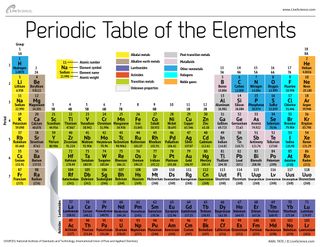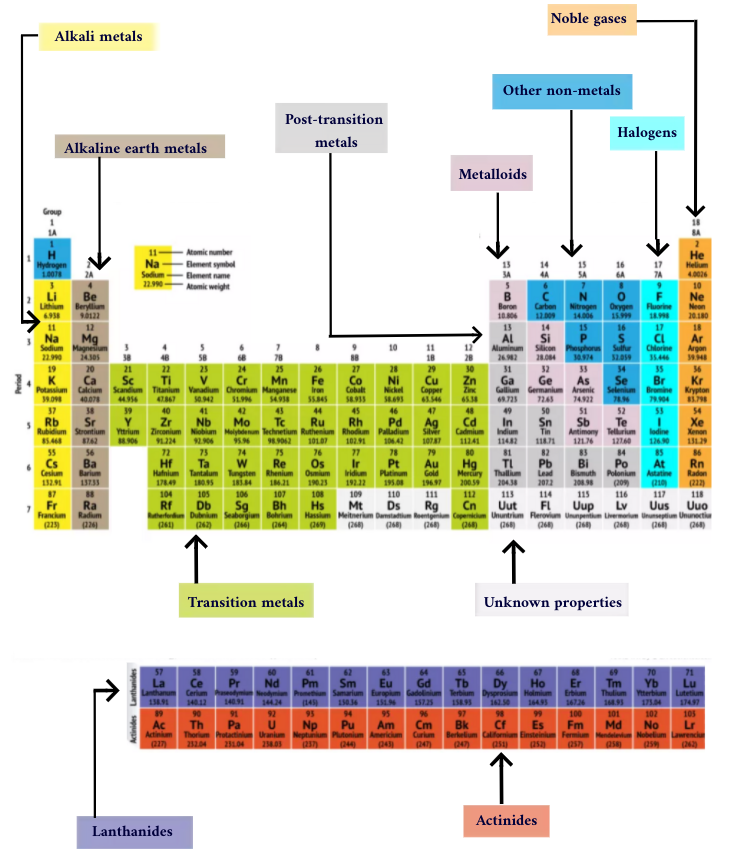In the Family of Alkali Metals, What Happens as You Move Down the Column?
How the Periodic Tabular array of the Elements is arranged

Scientists had a rudimentary agreement of the periodic table of the elements centuries ago. But in the late 19th century, Russian pharmacist Dmitri Mendeleev published his offset endeavour at grouping chemical elements according to their atomic weights. There were only about 60 elements known at the time, simply Mendeleev realized that when the elements were organized by weight, certain types of elements occurred in regular intervals, or periods.
Today, 150 years later, chemists officially recognize 118 elements (afterwards the improver of iv newcomers in 2016) and still utilise Mendeleev'southward periodic table of elements to organize them. The tabular array starts with the simplest atom, hydrogen, and so organizes the balance of the elements by atomic number, which is the number of protons each contains. With a scattering of exceptions, the order of the elements corresponds with the increasing mass of each atom.
The table has 7 rows and 18 columns. Each row represents one menstruation; the period number of an element indicates how many of its energy levels house electrons. Sodium, for case, sits in the third catamenia, which means a sodium atom typically has electrons in the first three free energy levels. Moving down the tabular array, periods are longer because it takes more electrons to fill the larger and more complex outer levels.
The columns of the table stand for groups, or families, of elements. The elements in a group often look and behave similarly, because they have the same number of electrons in their outermost vanquish — the face they evidence to the world. Group xviii elements, on the far right side of the tabular array, for case, have completely full outer shells and rarely participate in chemical reactions.
Elements are typically classified as either a metal or nonmetal, but the dividing line between the 2 is fuzzy. Metal elements are commonly skillful conductors of electricity and heat. The subgroups within the metals are based on the similar characteristics and chemical properties of these collections. Our clarification of the periodic table uses commonly accepted groupings of elements, co-ordinate to the Los Alamos National Laboratory.

Groups of the Periodic table
Brine metals: The brine metals brand up most of Grouping 1, the table's first cavalcade. Shiny and soft enough to cutting with a knife, these metals start with lithium (Li) and end with francium (Fr). They are also extremely reactive and volition burst into flame or even explode on contact with water, and then chemists shop them in oils or inert gases. Hydrogen, with its single electron, besides lives in Group i, but the gas is considered a nonmetal.
Alkaline-world metals: The alkaline metal-earth metals make up Group 2 of the periodic table, from beryllium (Be) through radium (Ra). Each of these elements has ii electrons in its outermost free energy level, which makes the element of group i earths reactive enough that they're rarely found alone in nature. Merely they're not as reactive as the alkali metals. Their chemic reactions typically occur more slowly and produce less heat compared to the alkali metals.
Lanthanides: The third group is much too long to fit into the third column, so information technology is cleaved out and flipped sideways to go the summit row of the island that floats at the bottom of the table. This is the lanthanides, elements 57 through 71 — lanthanum (La) to lutetium (Lu). The elements in this group take a silver white color and tarnish on contact with air.
Actinides: The actinides line the bottom row of the island and incorporate elements 89, actinium (Ac), through 103, lawrencium (Lr). Of these elements, simply thorium (Th) and uranium (U) occur naturally on Globe in substantial amounts. All are radioactive. The actinides and the lanthanides together grade a group called the inner transition metals.
Transition metals: Returning to the main body of the tabular array, the residuum of Groups three through 12 represent the rest of the transition metals. Difficult but malleable, shiny, and possessing practiced conductivity, these elements are what you typically think of when you hear the give-and-take metal. Many of the greatest hits of the metal globe — including gold, silver, iron and platinum — alive here.
Mail service-transition metals: Alee of the jump into the nonmetal world, shared characteristics aren't neatly divided along vertical group lines. The mail service-transition metals are aluminum (Al), gallium (Ga), indium (In), thallium (Tl), tin (Sn), pb (Pb) and bismuth (Bi), and they span Group 13 to Group 17. These elements have some of the classic characteristics of the transition metals, but they tend to be softer and deport more poorly than other transition metals. Many periodic tables will characteristic a bolded "staircase" line beneath the diagonal connecting boron with astatine. The post-transition metals cluster to the lower left of this line.
Metalloids: The metalloids are boron (B), silicon (Si), germanium (Ge), arsenic (Equally), antimony (Sb), tellurium (Te) and polonium (Po). They form the staircase that represents the gradual transition from metals to nonmetals. These elements sometimes behave as semiconductors (B, Si, Ge) rather than as conductors. Metalloids are as well chosen "semimetals" or "poor metals."
Nonmetals: Everything else to the upper right of the staircase — plus hydrogen (H), stranded way back in Grouping 1 — is a nonmetal. These include carbon (C), nitrogen (N), phosphorus (P), oxygen (O), sulfur (S) and selenium (Se).
Halogens: The meridian four elements of Group 17, from fluorine (F) through astatine (At), represent one of two subsets of the nonmetals. The halogens are quite chemically reactive and tend to pair up with alkali metals to produce various types of salt. The table salt in your kitchen, for example, is a matrimony between the alkali metal sodium and the element of group vii chlorine.
Noble gases: Colorless, odorless and almost completely nonreactive, the inert, or noble gases round out the table in Group 18. Many chemists expect oganesson (previously designated "ununoctium"), i of the iv newly named elements, to share these characteristics; however, considering this element has a half-life measuring in the milliseconds, no one has been able to test it directly. Oganesson completes the seventh period of the periodic tabular array, so if anyone manages to synthesize element 119 (and the race to do so is already underway), it volition loop around to start row eight in the alkaline metal cavalcade.
Because of the cyclical nature created past the periodicity that gives the table its name, some chemists prefer to visualize Mendeleev's table equally a circumvolve.
Boosted resources:
- Sentinel this cursory video nearly the periodic table and element groups, from Crash Course.
- Flip through this interactive periodic table of elements at ptable.com.
- Bank check out this gratuitous, online educational resource for understanding elemental groups from CK-12.
johnsonquichademad.blogspot.com
Source: https://www.livescience.com/28507-element-groups.html
0 Response to "In the Family of Alkali Metals, What Happens as You Move Down the Column?"
Postar um comentário